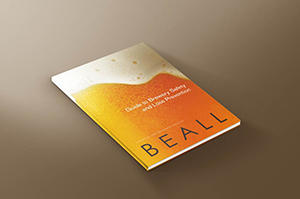The craft brewing industry, while incredibly rewarding, isn’t without its occupational hazards. For employers, understanding and mitigating these risks is crucial for the well-being of their team and the smooth operation of their business. Here are three of the most common brewery injuries and actionable steps employers can take to prevent them:
1. Slips, Trips, and Falls
Brewery floors are often wet due to spills, cleaning, and condensation. Add to that hoses, pipes, and equipment, and you have a recipe for slips, trips, and falls, leading to sprains, strains, fractures, or even head injuries.
Prevention Tips:
- Maintain excellent housekeeping: Implement a strict “clean as you go” policy. Spills, no matter how small, should be immediately cleaned up. Keep walkways clear of hoses, cords, and other obstructions.
- Invest in proper flooring and drainage: Ensure floors are made of slip-resistant materials. Install effective drainage systems to prevent standing water. Consider using anti-fatigue mats in areas where workers stand for long periods and where spills are frequent.
- Encourage appropriate footwear: Mandate slip-resistant, closed-toe footwear for all brewery staff. Steel-toed boots can offer additional protection from falling objects.
- Adequate lighting: Ensure all work areas are well-lit, especially in brewing and packaging areas, to improve visibility of potential hazards.
- Signage: Use clear, visible “Wet Floor” or “Caution” signs in hazardous areas.
2. Back and Muscle Strains (Musculoskeletal Injuries)
Brewery work is physically demanding. Lifting heavy kegs, bags of grain, and moving equipment, often in awkward postures or with repetitive motions, can lead to chronic back pain, sprains, and strains in the shoulders, neck, and wrists.
Prevention Tips:
- Implement proper lifting techniques training: Regularly train employees on correct lifting techniques: bend at the knees, keep the back straight, and lift with the legs, not the back. Emphasize keeping the load close to the body and avoiding twisting while lifting.
- Utilize mechanical aids: Invest in equipment like forklifts, pallet jacks, hand trucks, hoists, and conveyors to minimize manual lifting. For kegs, consider keg dollies or keg lifters.
- Ergonomic workspace design: Arrange workspaces to reduce reaching, bending, and awkward postures. Consider adjustable height tables for packaging lines.
- Encourage stretching and breaks: Promote regular stretching exercises and micro-breaks to alleviate muscle fatigue and improve flexibility.
- Team lifts: Encourage employees to ask for help when lifting heavy or awkward objects that are too much for one person.
3. Cuts and Lacerations
From broken glass bottles and sharp edges on equipment to handling knives for ingredients, cuts and lacerations are a persistent risk in breweries.
Prevention Tips:
- Provide proper Personal Protective Equipment (PPE): Mandate the use of cut-resistant gloves when handling glass, cleaning sharp equipment, or performing tasks that involve cutting. Ensure gloves fit properly.
- Safe handling procedures: Train employees on safe procedures for handling glass, especially during bottling and cleaning. Provide specific instructions for picking up broken glass (e.g., using a broom and dustpan, not bare hands).
- Machine guarding: Ensure all machinery with sharp or moving parts (e.g., mill augers, canning lines) has appropriate and well-maintained guards. Implement lockout/tagout procedures for maintenance and cleaning.
- Sharp tools and storage: Ensure knives and other cutting tools are kept sharp (dull blades require more force, increasing the risk of slips) and stored safely in designated racks or holders.
- Regular equipment inspections: Routinely inspect all equipment for sharp edges, burrs, or damaged parts that could cause injury. Promptly repair or replace damaged equipment.
By taking these proactive measures, brewery employers can significantly reduce the incidence of these common injuries, ensuring a safer, healthier, and more productive environment for their dedicated team.
For more than 30 years, Beall Financial and Insurance Services, Inc., has been helping corporations and individuals protect their most important assets. The agency’s client base covers a spectrum of niche businesses, such as craft breweries, that require specialized insurance packages and knowledge. With offices in California and Indiana, Beall Financial and Insurance Services serves clients nationwide.


